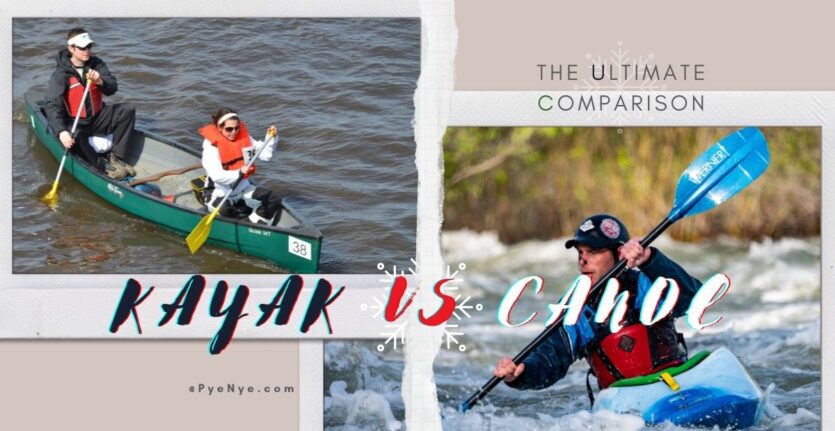It’s summertime, and there are tons of places to explore and adventure. This kayak vs canoe comparison is for those who don’t want to worry about what type of boat is best for them. However, kayaks and canoes both provide a similar type of experience. So which one is better? It really depends on the person!
The Canoe and kayak are two of the most popular water vessels used in the world. Both can be used for recreation. But there are clear differences between kayak and canoe. However, both canoes and kayaks have different purposes that depend on what you need or want to use them for.
The difference in stability is what might motivate people to prefer one over the other!
Kayaks are usually longer and narrower than canoes. They are also typically more expensive, depending on the material. A kayak is better for traveling long distances because it has less drag in the water. Canoes are better for shallow rivers or fishing, where kayaks may be unstable, but they both offer excellent adventure opportunities.
Let’s dive into the ultimate kayak vs canoe comparison;

Jump To A Section
A Brief To Kayaking Vs Canoeing
There are many upsides to kayaking. First, it is cheaper than canoeing; the cost of the boat, the paddle, and other equipment will be significantly less than what you would spend on a canoe. Secondly, it is easier to move around in a kayak while you paddle; it can be quite difficult to stay balanced in a canoe for any length of time. Thirdly, kayaks are more versatile than canoes. Because they are designed for both slow rivers and fast lakes.
Canoes are often used for recreational activities on calm, slow-moving rivers. Kayaks are used for more specialized fishing or hunting. If you want to go on calmer waters, the Canoe is your best option. For faster waters, kayaks are recommended. Here are the best river kayaking destinations in the US.
The History of the Canoe and Kayak
The history of the canoe and kayak is rooted in the earliest human beings. The earliest designs of these watercraft were built by early humans to hunt game, transport goods, and provide transportation in general. With time, these vessels developed into highly sophisticated machines, ones that can be used for recreation or to transport people across difficult waterways. So, around 40,000 years ago, humans started making boats out of animal skins that could be folded flat when not in use.
The word “canoe” comes from the Carib tribe of natives who inhabited the Caribbean and southern regions of North America, and their word for the boat was “canoe.” These early paddlers used this type of Canoe to explore and hunt along rivers and coastlines.
The Differences Between Kayaking vs. Canoeing
With many similarities, kayaking vs canoeing can be quite different. If you’re trying to choose between kayaking and canoeing, it’s important to understand the difference between kayak vs canoe first!
Kayaks are often preferred over canoes because they’re faster and more maneuverable. They have an open cockpit, which means that you have more control over steering and paddling. Although canoes are slower than kayaks, they are preferred by some people because of their stability on the water.
Kayaking and canoeing are both modes of boating that involve a person sitting on top of a boat as it is propelled through the water. Kayaks are more compact and maneuverable, while canoes are wider and faster. Kayaking is also considered a sport as people compete in races across short distances on lakes, rivers, and other bodies of water around the world.
Kayaks are typically smaller than canoes. The main difference between kayak vs canoe is that kayaks sit higher out of the water than canoes do. This is because they have a deck above the waterline where people sit. Canoes, on the other hand, are primarily used to transport items like groceries or equipment for camping trips.
Kayaking is especially for in-the-ocean adventures, like ocean kayak fishing. Where the waves are coming in from all directions. Unlike canoeing, kayaking is often much more challenging because of this aspect. With the instability caused by waves, many people see kayaking as more difficult because of its unpredictable nature. Here’s more about ocean kayaking.
Is a canoe or kayak more comfortable?
Kayaks vs canoes both offer different experiences depending on the type of water and environment they will be using in. The kayak is more stable in choppy water, while a canoe is more maneuverable.
A kayak is wider and has a cockpit. On the other hand, a canoe is a narrowboat with an open cockpit. In terms of comfort, it is more comfortable to sit in the kayak because it has a cockpit that keeps you from sitting in the water. The Canoe’s open cockpit means that you will be sitting in the water most of the time.
Is it Easier to Kayak or Canoe?
The question of whether it is easier to kayak or Canoe may not be an easy answer. Although, some people might argue that kayaks are the way to go for one main reason: they are easier to learn how to use. Many people find learning how to kayak is less complicated than trying to learn how to paddle a canoe.
With kayaks, people like to use their arms and the paddle, whereas. And with canoes, people like to use their legs. Because it is more about balancing. Generally, kayaking is easier for beginners because the paddle is shorter. On the other hand, canoes are easier for advanced skill levels. Because they allow paddlers to sit lower in the water. Which helps them from tipping over as easily as those using a kayak.
The major differences between a canoe and a kayak
Kayaks are smaller and more maneuverable than a canoe, which is better for paddling large distances. A kayak moves faster through the water. It also requires less energy to paddle one over a longer distance than a canoe does because it’s smaller and lighter.
Canoes are typically more stable, are usually wider in size, have flat bottoms, and are more often used for fishing. Kayaks are often narrower, have rounded bottoms, and are usually preferred for whitewater kayaking. A canoe has more stability because of the two-paddle setup, so an experienced paddler can sit more upright.
Kayaks are more efficient in the water as they have a better glide and higher velocity, but canoes offer a lot of stability. The bottom line is that it’s up to personal preference. However, kayaks are more efficient for those who want to use them for recreational purposes or those who need to cover a distance quickly. Kayaks are a little narrower than canoes which may be an issue if you’re attempting to bring a lot of gear on board.
A very big difference between kayak vs canoe is that canoes are generally broader, which means they have a larger surface area to displace water. Meanwhile, kayaks are much lighter and more maneuverable.
The most significant difference between kayak vs canoe is that while a kayak allows you to sit in a seated position, a canoe forces you to sit upright with your legs dangling in the water. When it comes to speed, both boats travel at about the same rate on calm water, but a kayak has a higher level of maneuverability because it is smaller and has a shorter paddle.
Designs And Shapes Comparison
The most obvious difference between kayak vs canoe is the shape. A canoe has a flat bottom, which provides more stability when transporting weight in it. The kayak’s hull is triangular, which is suited for speed over long distances or in rough waters.
Canoes are typically wider than kayaks, allowing for more stability when in use. Kayaks are sleeker in design, allowing for greater maneuverability than canoes.
A person who is considering going on a kayak adventure should keep in mind that kayaks have a more sleek, narrow design compared to a canoe. This means that they are composed of less surface area and formless drag through the water. A kayak can hold a lot of weight, but it is not able to carry as much gear as a canoe.
The Stability And Maneuverability
Kayaking and canoeing differ in a number of ways, but most importantly in the amount of stability they provide. Kayaks are, by design, more stable than canoes.
Kayaks are more stable than canoes, but most kayaks are not as maneuverable as canoes. The differences in stability and maneuverability between kayaks and canoes are most likely due to the fact that kayaks are shaped like a surfboard, which is much more stable than the hull of a canoe. Even though they may be harder to steer, kayak paddlers can move more quickly across open water because it is easier to balance on the boat’s narrow edge.
Kayaks are more stable because they have a wide flat bottom and a low center, but canoes are more maneuverable because they have a narrow flat bottom with a high center. A kayak usually has a narrower hull which offers more control over direction.
The stability and maneuverability of a canoe are determined by the weight it is carrying, the shape of the hull, and how deep it sits in the water.
Versatility Of Kayak And Canoe
Kayaks are more versatile, but canoes are cheaper and more stable on the water. Regardless of the kayak vs Canoe that you have chosen, I would suggest that you invest in a life jacket for each person who will be on the craft. If you plan to use a canoe on a larger body of water, it is a good idea to have some sort of signaling device in addition to a life jacket.
kayak vs Canoe Speed Comparison
Kayaks are faster than canoes because they are more streamlined and have a smaller surface area. They also have fewer appendages, which allows them to cut through the water with less resistance. Kayaks typically reach speeds of 10-12 miles per hour, whereas canoes often do not exceed speeds of 8 miles per hour.
This is because kayaks are much faster and narrower than canoes; their lighter weight makes them more buoyant and thus faster. The shape of a canoe limits its speed because its belly is so wide, which creates drag.
With different sizes, the speeds of kayak vs canoe are also vastly different. A kayak normally reaches its top speed of 17 miles per hour within 10 hours. Meanwhile, an average size canoe can reach its top speed of 9 miles per hour within 30 minutes.
Cockpit
The cockpit of a kayak is on the water, whereas a canoe is not. And it is typically narrower than the Canoe because it only has one set of thwarts for the paddler to sit on. There are many benefits to a kayak’s cockpit being exposed to the water, including enhanced control and stability. This enables people to use their upper body strength when paddling in order to steer with precision.
In contrast, a canoe is larger and broader with a pointed front and square-shaped back. A canoe typically has two sets of thwarts for the paddler’s butt to rest on, which causes the cockpit area to be wider.
Paddles comparison between kayak vs Canoe
While kayaks and canoes both have a paddle, the stroke can be quite different. The paddles are relatively similar in size, but the way they are used is quite different. A kayaker will often use one hand to hold their paddle while using it to move forward, whereas a canoeist will often use two hands on the paddle.
A kayak is a small one-person boat that is propelled by a double-bladed paddle. A canoe, on the other hand, is a large single-person boat that is propelled by a single-bladed paddle.
The comparison of paddles between kayak vs canoe has a great deal to do with the design. Canoes are wider than kayaks, so it is important to have a paddle with a longer blade for more power. Paddles are also shorter in length since they are not only operating for moving forward. But are also used for turning. If you have never paddled before, it is recommended that you start with a canoe paddle because there is less coordination involved.
Kayak vs Canoe Fishing Comparison
Kayaks are better for fishing because they are more maneuverable and easier to paddle than canoes and offer a stealthy approach. The Canoe can easily carry more weight than a kayak. A kayak is better for flat water fishing because it has little drag when moving through the water in calm weather.
Kayaks also have storage under the seat that is great for storing bait and gear. A canoe is shorter than a kayak, so it tends to tip over easier. The low sides of the Canoe also mean that fish can jump out of the boat, which makes it harder to catch fish.
Kayaking Techniques vs. Canoeing Techniques
Kayaking and canoeing are both forms of boat-like activities that require a person to carry themselves and their vessel on the water. Kayaking techniques focus on sitting in a pelvis rather than kneeling, which allows for better balance. Canoeing techniques often involve sitting with the legs through the holes in the boat, making it easier to paddle and steer.
In kayaking, the person sits in a seated position with their legs perpendicular to the surface of the water. The paddle is in one hand and in front of them, and they use it in a sweeping motion to make their way in the direction they want to go. In canoeing, there are two people paddling at once, and they each sit on opposite sides of the boat.
The kayak is propelled by utilizing the long-bladed, single-sided oars, which are used to create forward movement through the water.
The Difference Between Canoe And Kayak In The Olympics
The Olympic Games include two events for playing kayaks: the single and the double. The single event is played by one person, and the double event is played by two players who share a boat. The boats are different types of kayaks: and canoes. Canoes typically have a rounded hull and require more skill to balance on than a kayak.
The difference between Canoe vs kayak in the Olympics is that kayaks are used with a double-bladed paddle that is propelled by the arms, whereas canoes are propelled by using a single-bladed paddle using shoulder rotation. Canoes are also more stable than kayaks.
Canoe races typically consist of four lengths (1,000 meters), while kayak races consist of 2 lengths (500 meters).
Kayak vs Canoe which should I buy?
One consideration when deciding which kayak vs Canoe to purchase is the intended use. Specialized kayaks are designed for specific purposes such as fishing, surfing, and racing. Canoes are generally multipurpose boats. A kayak is a type of Canoe that has a closed cockpit with an opening at the stern for entry and exit that allows you to sit upright with your legs dangling in the water.
Kayaking and canoeing are both great options for enjoying the water and getting exercise. If you’re looking to buy a kayak, but you’ve never been in one before, I would recommend visiting a local boat shop and trying different models out to see which one feels most comfortable. Kayaks can be very expensive, so it is best to know what you want before shopping.
Kayaks and canoes both have many benefits that make them unique and useful for various purposes. The first thing to know about kayaks and canoes is that they serve various purposes. Kayaks are usually used for fishing, hunting, or exploring, whereas canoes are easier to maneuver and can carry more people or things. In terms of price, kayaks are less expensive than canoes, but they require a lot of skill to operate well.
Which One Is Safer Kayak vs Canoe?
There are differences between kayak vs canoe in safeties. Kayaks are a lot more maneuverable with a quick response to the paddles but require more skill and strength. Canoes are difficult to roll over, have a shallow draft, and allow for easier paddling. You can learn about canoeing and kayaking safety guidelines from here.
Canoes are great for smaller bodies of water and lakes, while kayaks are more stable in the water and can often go on larger lakes or oceans. Kayaks also have a raised backrest so you can catch your breath while peddling. A canoe has a higher chance of tipping over since it only has one flat bottom side with nothing to stop it from tipping over when there’s a bump in the water.
The Canoe is a safer option for beginners, as it offers a low center of gravity. Kayaks have a higher center of gravity and are more challenging to maneuver. The size of a canoe is less imposing, which may make it more appealing to the novice paddler.
Kayak is best for what?
Kayak is best for exploring most of the waterways. Because it has a rigid shell on top of a body that helps reduce the effects of waves on it. This is important because if someone were to go on a ride with waves, they would not be able to see what was ahead of them, and it could interfere with their navigation.
A kayak also helps reduce the amount of energy needed to move through the water. Kayaks are typically made out of plastic or fiberglass, and the boat’s shape creates stability. The seat can be adjusted to fit different heights, and it’s possible to control the kayak with both hands at the same time.
Advantages and disadvantages of a kayak
A kayak is a great way to exercise and a good workout, it’s a cheap form of transportation, and it’s more stable. Disadvantages: the paddles are less powerful than an oar, it’s less stable than a canoe on windy days, and canoes have more room for storage. Have a look at the benefits of kayaking as an exercise.
A kayak’s primary advantage is that it can be used in shallow water. It also offers a more natural stance for paddling, which reduces the risk of injury. One disadvantage is that an inexperienced kayaker may not feel safe when taking on very rough water. The risk of injury increases with the intensity of the waves. It’s also difficult to use a kayak for fishing because it does not allow one to cast or retrieve their line easily.
The Canoe is best for what?
The Canoe is best for rivers and lakes with calm, flat waters that are relatively shallow. This means that the Canoe is not able to be used in rough or choppy waters. They are also not able to be used in hot conditions because they become difficult to transport without a dock. The Canoe is the best mode of transportation because it allows you to see the beauty of the water and wildlife below.
Advantages And Disadvantages Of A Canoe
The Canoe is a great vessel that many people use for fishing, hunting, and exploring. It is a versatile boat that some may purchase for a second vehicle. A disadvantage of the Canoe, which is also an advantage in some cases, is its ability to be used in both calm and rough water. If there are choppy waters around, one may want to go with a kayak or other smaller vessel! Because the Canoe will get pushed around by waves more often than not.
When going out on a canoe, there are a few things to consider. It is important to have a life-jacket and a whistle in case of an emergency. The Canoe also offers a sense of adventure, which may be fun for some people. On the other hand, it is very hard to balance without tipping over when out on the water with a boat this small. This means that the person has to be sure about their paddling skills before getting too far away from shore.
Kayak Or Canoe Which One Is Better?
Many people have a preference when it comes to deciding which type of boat is best for them. The choice between a kayak vs a canoe will depend on the user.
If you are going to be going on a long trip, then it would be best to bring a kayak. If you are planning on only making short trips, then your best bet would be to use a canoe. Canoes are generally used for slow-moving rivers or lakes, while kayaks are used for fast-moving rivers or rapids.
I would highly suggest that you purchase a kayak over a canoe. Kayaks tend to be lighter weight and easier to transport than canoes, and they are also faster on the water.
Which One Is Bigger Kayak Or Canoe
Kayaks are usually smaller than canoes, but there is no universal size. Kayaks are perfect for fishing or paddling around the lake, but they are not designed to hold large amounts of passengers. The kayak is typically used by recreational paddlers, especially those who enjoy fishing. They often have a rudder at the back that helps with steering and control. A canoe is much larger than a kayak or raft, which means that it can carry more weight.
Kayaks have a large surface area which provides enough buoyancy to combat the instability of the hull shape, while canoes only have a small surface area and therefore need to be longer (and thus heavier) to achieve the same degree of stability.
In conclusion, it’s clear that kayaks offer greater stability and safety than canoes. Kayaks are also faster to paddle but require more skill to maneuver. Canoes are easier to paddle but offer less stability. The kayak is a better choice for someone who enjoys being on the water for long periods of time.
The Canoe, on the other hand, is just the right boat for someone who is looking for an easy paddle or is just getting into paddling in general.


